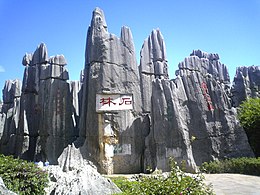South China Karst
| UNESCO World Heritage Site | |
|---|---|
 Stone Forest ( in Yunnan) | |
| Location | China |
| Criteria | Natural: (vii), (viii) |
| Reference | 1248bis |
| Inscription | 2007 (31st Session) |
| Extensions | 2014 |
| Coordinates | 24°55′24″N 110°21′16″E / 24.92333°N 110.35444°ECoordinates: 24°55′24″N 110°21′16″E / 24.92333°N 110.35444°E |
 Location of South China Karst in China | |
The South China Karst (simplified Chinese: 中国南方喀斯特; traditional Chinese: 中國南方喀斯特; pinyin: Zhōngguó Nánfāng Kāsītè), a UNESCO World Heritage Site since June 2007,[1] spans the provinces of Chongqing, Guangxi, Guizhou, and Yunnan. It is noted for its karst features and landscapes as well as rich biodiversity. The site comprises seven clusters Phase I: Libo Karst, Shilin Karst, and Wulong Karst inscribed in 2007, and Phase II: , , Jinfoshan Karst, and inscribed in 2014.[2] UNESCO describes the South China Karst as "unrivalled in terms of the diversity of its karst features and landscapes."[1]
South China Karst - UNESCO inscription details[]
| UNESCO Inscription No |
Name |
|---|---|
| 1248-001 | Shilin Karst - Naigu Stone Forest (乃古石林) |
| 1248-002 | Shilin Karst – Suogeyi Village (所各邑村) Shilin Yi Autonomous County |
| 1248-003 | Libo Karst – Xiaoqijong (小七孔) Libo County |
| 1248-004 | Libo Karst – Dongduo (洞多) Libo County |
| 1248-005 | Wulong Karst – Qingkou Giant Doline (Tiankeng) (箐口天坑) Wulong County |
| 1248-006 | Wulong Karst – Three Natural Bridges (天生三桥) Wulong County |
| 1248-007 | Wulong Karst – Furong Cave (芙蓉洞) Wulong County |
| 1248-008 | Guilin Karst – Putao Fenling |
| 1248-009 | Guilin Karst – Lijiang Fengcong
Yangshuo County |
| 1248-010 | Shibing Karst |
| 1248-011 | Jinfoshan Karst |
| 1248-012 | Huanjiang Karst |
Gallery[]
| Wikimedia Commons has media related to South China Karst. |

The Shilin (Stone Forest) South China Karst formations scenery
Karst limestone stalactites in the Furong Cave.
Tianlong Bridge, a South China Karst natural arch.
References[]
- ^ a b "Twenty-two new sites inscribed on UNESCO's World Heritage List, and one deleted during Committee meeting in Christchurch". UNESCO World Heritage Convention. 29 June 2007. Retrieved 2011-02-14.
- ^ "South China Karst". UNESCO.
External links[]
- Karst formations of China
- Landforms of Chongqing
- Landforms of Guangxi
- Landforms of Guizhou
- Geography of Kunming
- Rock formations of China
- Tourist attractions in Chongqing
- Tourist attractions in Guangxi
- Tourist attractions in Guizhou
- Tourist attractions in Yunnan
- World Heritage Sites in China
- Karst formations of Yunnan



